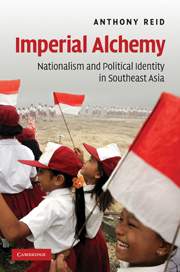Book contents
- Frontmatter
- Contents
- List of maps
- List of figures
- List of tables
- Acknowledgements
- Abbreviations
- 1 Nationalism and Asia
- 2 Understanding Southeast Asian nationalisms
- 3 Chinese as a Southeast Asian ‘other’
- 4 Malay (Melayu) and its descendants: multiple meanings of a porous category
- 5 Aceh: memories of monarchy
- 6 Sumatran Bataks: from statelessness to Indonesian diaspora
- 7 Lateforming ethnie in Malaysia: Kadazan or Dusun
- 8 Imperial alchemy–revolutionary dreams
- Glossary
- References
- Index
6 - Sumatran Bataks: from statelessness to Indonesian diaspora
Published online by Cambridge University Press: 01 April 2010
- Frontmatter
- Contents
- List of maps
- List of figures
- List of tables
- Acknowledgements
- Abbreviations
- 1 Nationalism and Asia
- 2 Understanding Southeast Asian nationalisms
- 3 Chinese as a Southeast Asian ‘other’
- 4 Malay (Melayu) and its descendants: multiple meanings of a porous category
- 5 Aceh: memories of monarchy
- 6 Sumatran Bataks: from statelessness to Indonesian diaspora
- 7 Lateforming ethnie in Malaysia: Kadazan or Dusun
- 8 Imperial alchemy–revolutionary dreams
- Glossary
- References
- Index
Summary
As explained in chapter 2, states had relatively little direct control over the inhabitants of the tropical rain-forests of Southeast Asia when compared with the great river systems of the temperate zone. For many peoples of the Southeast Asian uplands in particular, statelessness was not simply a negative absence or slowness to develop states, but a deliberate rejection of the manner in which trade-based coastal states had been experienced as a threat to their way of life. The highland populations of northern Sumatra, collectively known for several centuries as Bataks, will be our prime example of this category.
Like terms elsewhere in the region such as Toraja, Dayak, Dusun, Alfur or Karen, the term Batak was probably first used by coastal people as a generic descriptor of highlanders outside the boundaries of the civilisation defined by states and scriptural religions. These highlanders constituted the great majority of the population of Sumatra before 1870, and were themselves divided by a range of linguistic and cultural variations. They therefore defined themselves internally in terms of location, river-valley, dialect or descent. Yet when dealing with outsiders they appear to have accepted the broad label Batak, even including its ‘savage’ associations which served to intimidate potential intruders. The historical options for such peoples were either to be individually assimilated to the coastal states, or to forge new identities of sufficient breadth to demand a position of equality with the state-based identities of the coasts.
- Type
- Chapter
- Information
- Imperial AlchemyNationalism and Political Identity in Southeast Asia, pp. 145 - 186Publisher: Cambridge University PressPrint publication year: 2009



